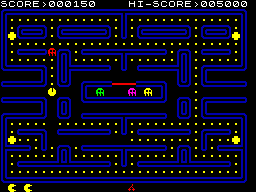At the Earl's Court Computer Fair in the summer of last year, DJL Software (remember that excellent Froggy program?) had on show a true Pacman program - albeit an unfinished version. A notice above the screen said, "Watch our advertisements for the release of this excellent program". We did, but nothing happened!
So, at the Christmas ZX Microfair, the question was put to DJL Software: what's happened to the Pacman program? "Ah well, Atari will now be marketing it." So does this mean the program will be mega-expensive? "Ah well, £14.95", came the sheepish reply.
However, at last a copy fell into our grubby little paws - see the screen shot. It was a pre-release cassette, without instructions and bearing a sticky address label. It loaded quickly and worked happily with the AGF, Protek and Kempston joystick interfaces; sadly there's no provision for Interface 2, but this omission may well be rectified before the game appears officially in the shops under the Atarisoft label.
Once the type of control has been selected, the game starts with a press of the 'S' key. A very complex maze appears, that's almost the
Fruits appear on the screen at various intervals during the game, but they don't hang around for very long. And as you progress through the screens, the effect of the power pills decreases while the speed of the ghosts increases, making the game even harder.
Power Pac'ed Prices
This is the ultimate version of Pacman that many people have been waiting for - yes, it's 100 per cent true to the original. However, at £14.95, it can only be described as grossly overpriced and therefore unlikely to sell in large quantities. As we revealed in our last issue, Atari also has plans to release other arcade games under the Atarisoft label, for most home computers. These are expected to include Moon Patrol, Defender, Ms Pacman and Centipede. But don't hold your breath waiting for Atari to revise its prices before release. If they haven't learned before, they're unlikely to learn now.Gavin Monk
Players must collect and empty dustbins into a moving rubbish cart while avoiding a variety of hazards - like speeding cars, pavement cyclists, vicious dogs, over-eating and one too many in the pub. There are seven levels of play, which is not all that many when compared with some of the games around today, but if the end result is anything like as good as NGS's previous software then it must have credibility.

Pacman from Atarisoft. It's the real McCoy.